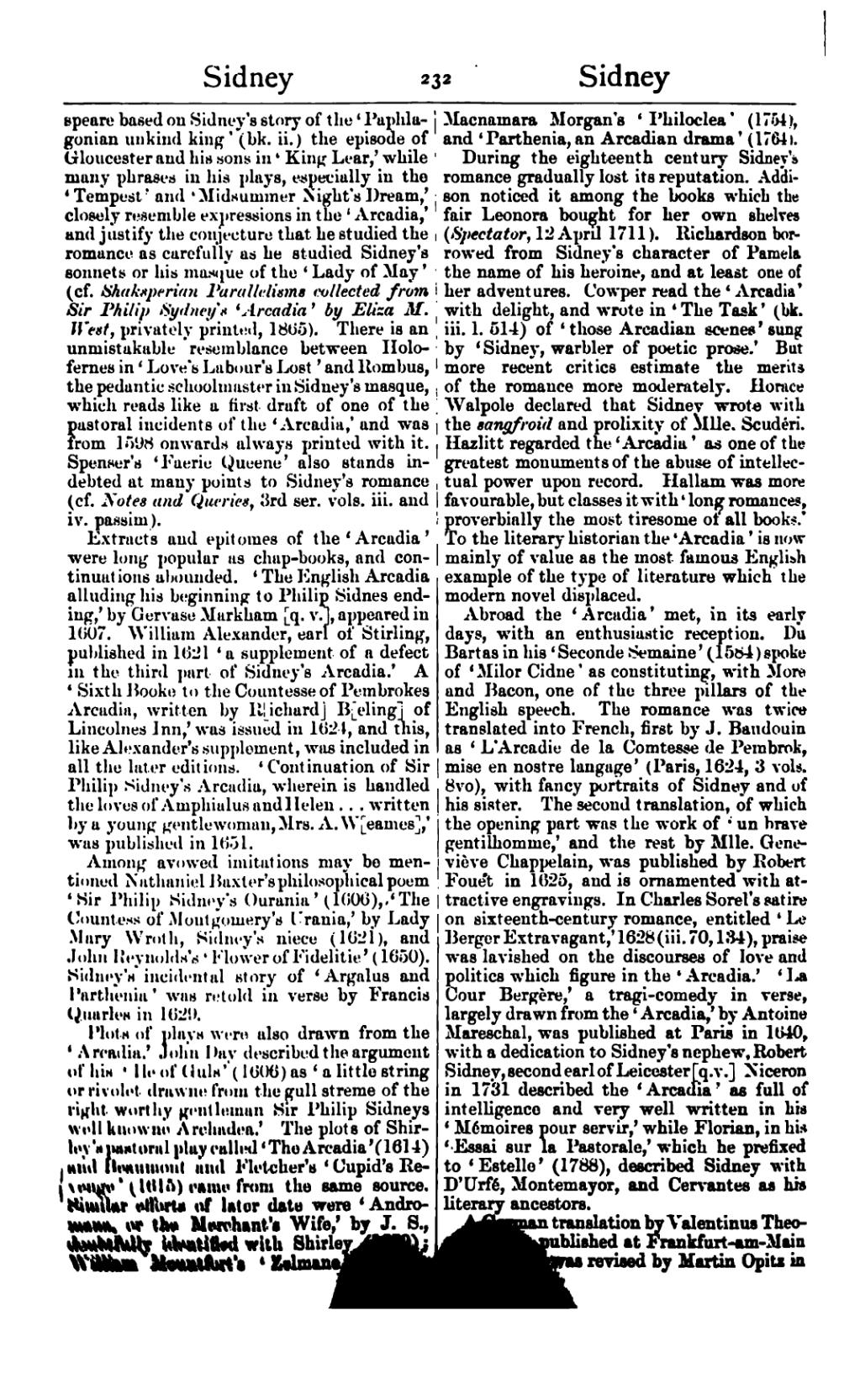speare based on Sidney's story of the ‘Paphlagonian unkind king’ (bk. ii.) the episode of Gloucester and his sons in ‘King Lear,’ while many phrases in his plays, especially in the ‘Tempest’ and ‘Midsummer Night's Dream,’ closely resemble expressions in the ‘Arcadia,’ and justify the conjecture that he studied the romance as carefully as he studied Sidney's sonnets or his masque of the ‘Lady of May’ (cf. Shaksperian Parallelisms collected from Sir Philip Sydney's ‘Arcadia’ by Eliza M. West, privately printed, 1865). There is an unmistakable resemblance between Holofernes in ‘Love's Labour's Lost’ and Rombus, the pedantic schoolmaster in Sidney's masque, which reads like a first draft of one of the pastoral incidents of the ‘Arcadia,’ and was from 1598 onwards always printed with it. Spenser's ‘Faerie Queene’ also stands indebted at many points to Sidney's romance (cf. Notes and Queries, 3rd ser. vols. iii. and iv. passim).
Extracts and epitomes of the ‘Arcadia’ were long popular as chap-books, and continuations abounded. ‘The English Arcadia alluding his beginning to Philip Sidnes ending,’ by Gervase Markham [q. v.], appeared in 1607. William Alexander, earl of Stirling, published in 1621 ‘a supplement of a defect in the third part of Sidney's Arcadia.’ A ‘Sixth Booke to the Countesse of Pembrokes Arcadia, written by R[ichard] B[eling] of Lincolnes Inn,’ was issued in 1624, and this, like Alexander's supplement, was included in all the later editions. ‘Continuation of Sir Philip Sidney's Arcadia, wherein is handled the loves of Amphialus and Helen … written by a young gentlewoman, Mrs. A. W[eames],’ was published in 1651.
Among avowed imitations may be mentioned Nathaniel Baxter's philosophical poem ‘Sir Philip Sidney's Ourania’ (1606), ‘The Countess of Montgomery's Urania,’ by Lady Mary Wroth, Sidney's niece (1621), and John Reynolds's ‘Flower of Fidelitie’ (1650). Sidney's incidental story of ‘Argalus and Parthenia’ was retold in verse by Francis Quarles in 1629.
Plots of plays were also drawn from the ‘Arcadia.’ John Day described the argument of his ‘Ile of Guls’ (1606) as ‘a little string or rivolet drawne from the gull streme of the right worthy gentleman Sir Philip Sidneys well knowne Archadea.’ The plots of Shirley's pastoral play called ‘The Arcadia’ (1614) and Beaumont and Fletcher's ‘Cupid's Revenge’ (1615) came from the same source. Similar efforts of later date were ‘Andromana, or the Merchant's Wife,’ by J. S., doubtfully identified with Shirley (1660); William Mountfort's ‘Zelmane’ (1705); Macnamara Morgan's ‘Philoclea’ (1754), and ‘Parthenia, an Arcadian drama’ (1764).
During the eighteenth century Sidney's romance gradually lost its reputation. Addison noticed it among the books which the fair Leonora bought for her own shelves (Spectator, 12 April 1711). Richardson borrowed from Sidney's character of Pamela the name of his heroine, and at least one of her adventures. Cowper read the ‘Arcadia’ with delight, and wrote in ‘The Task’ (bk. iii. l. 514) of ‘those Arcadian scenes’ sung by ‘Sidney, warbler of poetic prose.’ But more recent critics estimate the merits of the romance more moderately. Horace Walpole declared that Sidney wrote with the sangfroid and prolixity of Mlle. Scudéri. Hazlitt regarded the ‘Arcadia’ as one of the greatest monuments of the abuse of intellectual power upon record. Hallam was more favourable, but classes it with ‘long romances, proverbially the most tiresome of all books.’ To the literary historian the ‘Arcadia’ is now mainly of value as the most famous English example of the type of literature which the modern novel displaced.
Abroad the ‘Arcadia’ met, in its early days, with an enthusiastic reception. Du Bartas in his ‘Seconde Semaine’ (1584) spoke of ‘Milor Cidne’ as constituting, with More and Sir Nicholas Bacon, one of the three pillars of the English speech. The romance was twice translated into French, first by J. Baudouin as ‘L'Arcadie de la Comtesse de Pembrok, mise en nostre langage’ (Paris, 1624, 3 vols. 8vo), with fancy portraits of Sidney and of his sister. The second translation, of which the opening part was the work of ‘un brave gentilhomme,’ and the rest by Mlle. Geneviève Chappelain, was published by Robert Fouet in 1625, and is ornamented with attractive engravings. In Charles Sorel's satire on sixteenth-century romance, entitled ‘Le Berger Extravagant,’ 1628 (iii. 70, 134), praise was lavished on the discourses of love and politics which figure in the ‘Arcadia.’ ‘La Cour Bergère,’ a tragi-comedy in verse, largely drawn from the ‘Arcadia,’ by Antoine Mareschal, was published at Paris in 1640, with a dedication to Sidney's nephew, Robert Sidney, second earl of Leicester [q. v.] Niceron in 1731 described the ‘Arcadia’ as full of intelligence and very well written in his ‘Mémoires pour servir,’ while Florian, in his ‘Essai sur la Pastorale,’ which he prefixed to ‘Estelle’ (1788), described Sidney with D'Urfé, Montemayor, and Cervantes as his literary ancestors.
A German translation by Valentinus Theocritus was published at Frankfurt-am-Main in 1629, and was revised by Martin Opitz in
